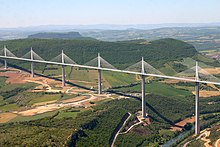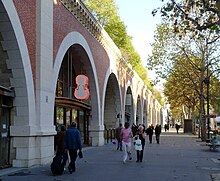Viaduct
 The 1812 Laigh Milton Viaduct in Ayrshire – the oldest surviving railway bridge in Scotland | |
| Ancestor | Trestle bridge, Box girder bridge |
|---|---|
| Related | Aqueduct |
| Descendant | None |
| Carries | Expressways, highways, streets, railways |
| Span range | Short (multiple) |
| Material | reinforced concrete, prestressed concrete, masonry |
| Movable | No |
| Design effort | medium |
| Falsework required | available for use, since viaducts are all composed of low bridges. |
A viaduct is a specific type of bridge that consists of a series of arches, piers or columns supporting a long elevated railway or road. Typically a viaduct connects two points of roughly equal elevation, allowing direct overpass across a wide valley, road, river, or other low-lying terrain features and obstacles.[1][2] The term viaduct is derived from the Latin via meaning "road", and ducere meaning "to lead". It is a 19th-century derivation from an analogy with ancient Roman aqueducts.[1] Like the Roman aqueducts, many early viaducts comprised a series of arches of roughly equal length.
Over land

The longest viaduct in antiquity may have been the Pont Serme which crossed wide marshes in southern France.[3] At its longest point, it measured 2,679 meters with a width of 22 meters.
Viaducts are commonly used in many cities that are railroad
Many viaducts over land connect points of similar height in a landscape, usually by bridging a river valley or other eroded opening in an otherwise flat area. Often such valleys had roads descending either side (with a small bridge over the river, where necessary) that become inadequate for the traffic load, necessitating a viaduct for "through" traffic.. Others were built to span settled areas, crossing over roads beneath—the reason for many viaducts in London.
Over water

Viaducts over water make use of islands or successive arches. They are often combined with other types of bridges or tunnels to cross navigable waters as viaduct sections, while less expensive to design and build than tunnels or bridges with larger spans, typically lack sufficient horizontal and vertical clearance for large ships. See the
The
Land use below viaducts
Where a viaduct is built across land rather than water, the space below the arches may be used for businesses such as car parking, vehicle repairs, light industry, bars and nightclubs. In the United Kingdom, many railway lines in urban areas have been constructed on viaducts, and so the infrastructure owner Network Rail has an extensive property portfolio in arches under viaducts.[7] In Berlin the space under the arches of elevated subway lines (S-Bahn) is used for several different purposes, including small eateries or bars.
Past and future
Other uses have been found for some viaducts. In Paris, France, a repurposed rail viaduct provides a garden promenade on top and workspace for artisans below. The garden promenade is called the Coulée verte René-Dumont while the workspaces in the arches below are the Viaduc des Arts. The project was inaugurated in 1993. Manhattan's High Line, inaugurated in 2009, also uses an elevated train line as a linear urban park.
In Indonesia viaducts are used for railways in

See also
References
- ^ a b "viaduct – Definition of viaduct in English by Oxford English Dictionary". OED. Retrieved 21 September 2020.
- ^ "Definition of VIADUCT". www.merriam-webster.com. Retrieved 27 March 2018.
- ISBN 0-521-39326-4, p. 99
- ^ Brownlee, Christy (March 2005) "Taking the high road: France's new bridge helps a small town dodge traffic—and set a new world record" SuperScience 16(6): pp.12–15;
- ^ Davidsen, Judith (April 1993) "A new "lite" rail viaduct formula: Norman Foster designs a rapid-transit viaduct for Rennes, France" Architectural Record 181(4): p.26;
- ^ Longest bridge, Guinness World Records. Last accessed July 2011.
- ^ "Light Industrial Units To Let/Rent | Small Industrial Space". Archived from the original on 17 May 2012.
- ^ "Toronto built, then demolished an expressway" (PDF). tac-atc.ca. Archived from the original (PDF) on 6 July 2011. Retrieved 27 March 2018.

